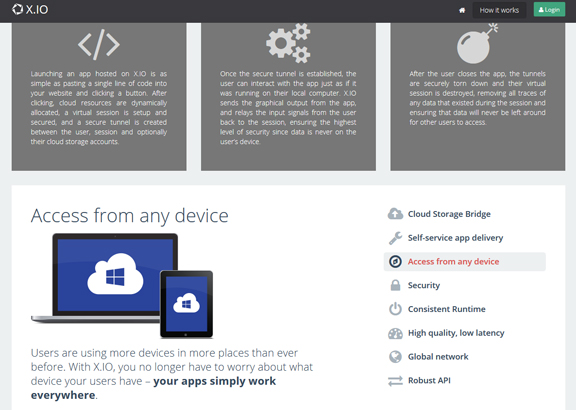Latest News
August 15, 2014
OTOY, the Los Angeles-based company with technologies to stream games and render graphics in the cloud, has just launched an application-streaming platform, dubbed X.IO.
The announcement came from the show floor of SIGGRAPH 2014 (Aug 10-14, Vancouver, Canada), the annual conference for graphics industry veterans and pioneers. OTOY describes X.IO as “a new application virtualization service that instantaneously ports Windows desktop applications to the cloud without needing to modify any code, enabling users to access them on any Internet-connected device, regardless of form factor or platform ... [It] was built from the ground up to handle the demanding nature of graphics-intensive applications, including image editing, CAD, and 3D modelling and rendering applications ...”
For CAD vendors with design programs originally written for Windows-based desktops, X.IO offers a shortcut to the cloud. In a demo video, OTOY promises the vendors’ software titles could become cloud-hosted streaming applications “with no drop in performance, no major redevelopment.” The platform gives users the option to integrate their existing cloud-hosted storage (such as Dropbox or Google Drive).
Like OTOY, Numecent is also offers its app-streaming platform Numecent NaaS (native app as a service). Numecent describes its service as a “white-label cloudpaging,” The company writes, “One of the benefits of cloudpaging is that it can reduce the digital delivery time of any native application by between 20x and 100x by pre-virtualizing the asset to be delivered. However, it is important to realize that we do not transmit pixels from the cloud—nor do we execute the application on a server. Instead, cloudpaging transmits pre-virtualized software instructions from the cloud (a page at a time and on-demand) which are then executed on the user’s machine in a transient manner.” As a white-label vendor, Numecent gives its client the right to stamp the hosted product with its own brand. Numecent’s technology will work as an invisible component behind the scene.
The cloud commerce is driven partly by the software consumers’ shifting preference for lightweight, mobile devices, but the new usage also requires powerful backend hardware to facilitate streaming experience that rivals local computing. At SIGGRAPH, GPU maker NVIDIA announced the availability of one such hardware, the NVIDIA VCA (visual computing appliance). The hardware was first unveiled at GTC 2014 in March under the name iRay VCA. In a box configured with 8 highend NVIDIA GPUs with 20 Intel Xeon E5 CPU cores, the VCA is designed to offer on-demand rendering over a network. In addition to the NVIDIA VCA, the company also offers the NVIDIA Grid VCA, a network appliance to host and deliver virtual computing with GPU-acceleration.
Historically, CAD users relied on workstations to run professional design software titles because other types of hardware—consumer PCs and mobile devices—failed to deliver good performance from such software. However, the move to run the same software titles remotely through virtualization is gaining momentum. Better bandwidth and compression algorithms have made it possible to offload the lion’s share of the computing to server-side operations and transmit only the visuals back to the users. The trend has also given birth to new licensing models, like subscription-based Desktop as a Service (DaaS), offered by VMWare’s Horizon division. All these developments signal a new attitude among technology consumers. Instead of purchasing and owning hardware and software, they may be looking to pay for access to both, when they need it, where they need it.
One major hurdle, however, still remains for CAD vendors who want to stake a claim in the cloud commerce. Windows-based CAD programs originally written for the desktop don’t have mobile-friendly functions. To accommodate mobile devices with multitouch functions, they would have to break from the CAD modeling interfaces previously written for mouse and keyboard input. That’s a daunting task few have tackled successfully. The introduction of such changes must also be carefully weighed against the risk of inconveniencing users who prefer to stick to the familiar desktop environment. While many may find the streaming approach appealing, some may want to use the streaming app from a less expensive, lighter PC, not a mobile device. In some instances, satisfying both groups in the same code base may not be possible.
Subscribe to our FREE magazine, FREE email newsletters or both!
Latest News
About the Author
Kenneth Wong is Digital Engineering’s resident blogger and senior editor. Email him at [email protected] or share your thoughts on this article at digitaleng.news/facebook.
Follow DE






